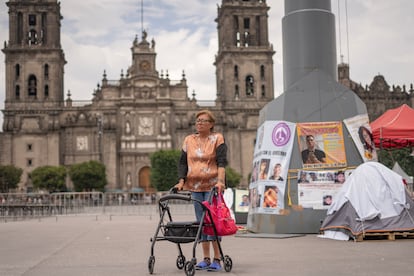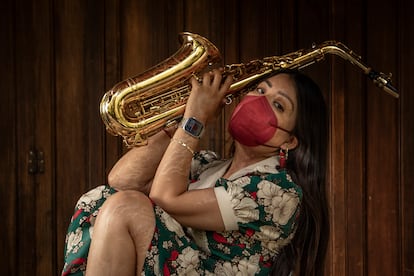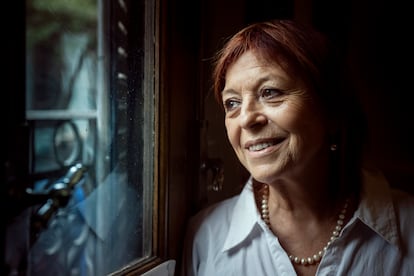This is the web version of Americanas, the newsletter from EL PAÍS América that addresses news and ideas with a gender perspective. If you want to subscribe, you can do so in this link.
There are phrases and individuals capable of easily summarizing the limitations or flaws of each time. It is possible that Jaime Sanín Echeverri (1922-2008), journalist and columnist for the conservative newspaper The Colombian of Medellín, was one of them. In her opinion, journalism was not a profession suitable for women because she thought that the long days of staying up late, the adrenaline rush of having to deal with printing errors and typos, or the simple fact of having to smear one’s fingers with ink disqualified them from entering the newsrooms of the time. Sagredo, as she signed her columns, insisted that the female world should be, on the contrary, “delicate, neat and domestic.”
The anecdote takes place in the early 40s of the last century in a city jealous of its traditions like Medellín, and is part of the book Battles for belonging (Lexington Books, 2024), by the doctor in History and academic at the Center for Journalism Studies (CEPER) of the University of the Andes Sandra Sánchez (Bogotá, 45 years old). The author vindicates the journalistic work of a handful of women in the 40s, 50s and 60s of the last century in publications such as the magazines Mireya (1943), Female agitation (1944) and Women (1961), or the weeklies TRUE (1955) and Female world (1953). “This is a history of the first half of the 20th century through the lenses of women. It is an effort to fill an obvious gap in historiography, but also to show that many of the contradictions of journalism and women of that time still exist today,” she says.
Women’s right to vote in Colombia was approved on August 25, 1954. Almost exactly one year after the only and fleeting military dictator in the country’s contemporary history came to power for a period of four years. These are just dates and characters that Sánchez uses to shed strong light on the desire for social struggle of reporters like Flor Romero, Mariaurora Escovar, Josefina Canal, Mercedes Triana or Ofelia Urib. “From the magazines [feministas] “The right to vote was defended, of course, but their idea of citizenship went much further. It had more to do with a desire for complete political intervention, through the written world of journalism, for example, where they could address other problems and distort the viewpoint of the traditional press produced by men,” says Sánchez.
It refers to the hyperpoliticization of a media system locked in a binary vision of the world. The content of traditional headlines such as The Time, The Spectator, The New Century, The Herald either Week It served as a trench for the defense of the political project of the Liberal and Conservative parties, omnipresent in the life of the country until the end of the 20th century. For this reason, perhaps, the focus on rural violence, bipartisan quarrels and sports became insufficient for this group of women, as the academic explains: “They became aware that the coverage dominated by men was incomplete because by wanting to legitimize partisan and power interests, they were unable to investigate or delve into the causes of reality. Of the armed conflict. Of injustice. What these women achieve is to broaden the content. To put on the table other issues associated with the tension between the search for female autonomy and the political use of their body.”
Issues that seem obvious today, but in those days were radical missiles against a centralist, male and white order. It is also fair to say that their reach was limited. Womenfounded by the diplomat Flor Romero in 1961, was the one with the largest circulation. In addition to being the first to use its own printing presses, a luxury that in those 60s only the almighty could afford The Weather from Bogotá. “In terms of volume, Women It was very important. But I think that Female agitationfounded in the 1940s in Tunja by Ofelia Romero, was a more disruptive publication,” says Sánchez. Its area of influence was perhaps greater, and its impact definitive when it came to confronting patriarchal stereotypes and generalizations that pigeonholed women into a passive role in society.
Newsletter
Analysis of current events and the best stories from Colombia, every week in your inbox
RECEIVE IT
Her editorials and articles highlighted the female potential within the labour market and the new spaces that were gradually opening up to gain ground in the economic and power spheres. Ultimately, it is a work of in-depth analysis and archives to rescue one of the first feminist waves in a South American country where social barricades often appealed to arms, rather than to the confrontation of ideas.
That is why Sánchez widens the angle and recalls other figures of the Latin American struggle such as the Argentine Paulina Luisi or the Brazilian Bertha Lutz. Characters who crossed paths in the corridors of regional congresses since the beginning of the century to dissect with rage and indignation the multiple problems posed by, for example, the gap in access to education, the first institutional dam in the fight against exclusion.
Thanks to the tenacity of these voices in Colombia, in 1933 the decree was passed granting women access to higher education and university. Also in 1953, pregnant or lactating women were protected with job security. All these events encompass the same period of study: “Not only was the political aspect present, but also the cultural aspect. Ofelia Uribe made her debut with radio programs, not as a guest, but as the host of a space with a feminine stamp that adds to the power struggle over what is told, how it is told and who tells it,” details Sánchez.
The following decades saw a reduction, at least in intensity, of this type of publication. More women entered journalism or communication faculties and entered newsrooms better prepared. However, the germ of machismo that sprouted in those years is still latent in most traditional media where the first generation made a place for themselves through hard work, as typists or secretaries, before making the leap to sections such as the social or leisure pages. A place assigned by the directors to limit their capabilities and sufficient reason for them to seek their own path and refuse to be relegated to ostracism.
None of the journalists mentioned went into the field to cover the armed conflict in Colombia, as other names in the United States or Europe had done since the Spanish Civil War, venturing to report on human barbarity. Reporters like Ligia Riveros in the 80s, or Martha Ruiz and Juanita León in the 90s, or Catalina Gómez Ángel today. “I don’t want to glorify or idealize these women either,” the academic clarifies. “I am interested in highlighting the paradoxes: their approaches to power, their uncritical adherence to the rhetorical frameworks of the progress policies that reached the region from the United States, or their silence on other exclusions.”
Sánchez also highlights the paradoxes of journalism, which today, as in the 1960s, operates on unstable ground: “Economic precariousness is what ends up destroying each of these publications. The large conglomerates of the southern cone come to the rescue of some of them. There are still publications, but they are marginal and very intermittent. That also interests me, to continue investigating the small stories of the few stubborn people w
ho continue to bet on finding other voices, on telling other lives.”
The question that arises next is what are the connecting threads between the decades covered by the book and the digital and social media era? Today, where gender references and debates converge, with all kinds of feminisms, labels and collectives that have brought to the table an endless tangle of disputes about the historical, philosophical and institutional nature of power.
The dissection of power returns, time and again, to the same starting point. Each time with new layers, some more nebulous than others, but in our days amplified by the ferocity of social networks: “The militant and feminist media of the two generations in Colombia are similar in some things and have several differences. Both seek to put issues on the agenda, to build a voice,” says the academic. “However, in the first half of the last century, publications were not limited to being just niche. Because of their historical context, more effective listening was previously sought. Today, when so much ground has been gained, each medium is withdrawn into its own context and I think that is why, ultimately, they are less willing to dialogue with other actors on the political scene or the powerful. 70 or 80 years ago they understood better that to resist you also have to be covered in that.”
These are our recommended articles of the week:
It is heartbreaking to see again and again this connection between classical history, masculine from the beginning, and some contemporary ways of avoiding listening to women in public.

The refusal of many EU governments to help Commission President Ursula von der Leyen form a gender-balanced team is a symptom of the long road to equality that remains to be travelled in much of Europe

A group of women organized a peaceful protest in front of the National Palace to remind the government of the Mexican state’s debt to its missing persons.

The Oaxacan saxophonist attacked with acid denounces a judicial process riddled with irregularities that almost left her attacker, an important local businessman and former PRI deputy, free.

The president of Feminists Without Borders talks about the accusation of gender violence against former President Fernández and Milei’s policies in her country: “Her freedom is that of extreme individualism,” she says.
Thank you very much for joining us and see you next Monday! (If you have been sent this newsletter and would like to subscribe to receive it in your email, You can do it here).
#Women #stay #late #smear #fingers #ink